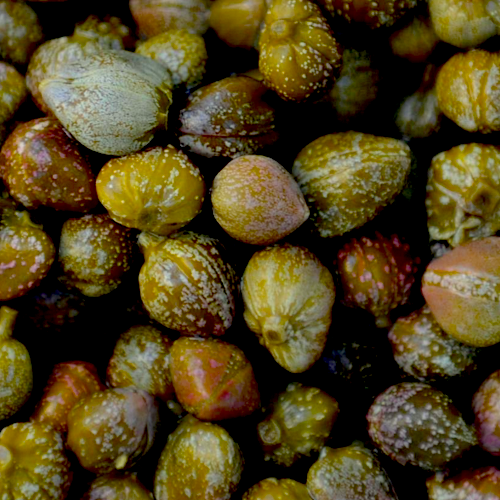|
|
Developmental Biology - Autophagy
Pickled Capers Activate Brain & Heart Proteins
A compound commonly found in pickled capers regulates proteins that control important body processes...
A compound commonly found in pickled capers has been shown to activate proteins required for normal brain and heart activity. It may even lead to future therapies for the treatment of epilepsy and abnormal heart rhythms.
Researchers from the University of California, Irvine School of Medicine have discovered that a compound named quercetin, commonly consumed when eating capers, directly regulates proteins neeed for heartbeat, thought, muscule contraction, and normal function of thyroid, pancreas and gastrointestinal tract.
Published in Communications Biology, the discovery was made by the laboratory of Geoffrey Abbott PhD, Professor, Department of Physiology and Biophysics at the University of California, Irvine School of Medicine. Kaitlyn Redford, a graduate student in the Abbott Lab, was first author on the study.
The Abbott Lab found quercetin, a plant-derived bioflavonoid, modify potassium ion channels in the KCNQ gene family. These channels are very influential in human health. Their dysfunction is linked to several common human diseases: diabetes, cardiac arrhythmia, and epilepsy.
"Now that we understand how quercetin controls KCNQ, future medicinal chemistry studies can be created to optimize quercetin-related small molecules for potential use as therapeutic drugs."
Geoffrey W. Abbott PhD, Bioelectricity Laboratory, Department of Physiology and Biophysics, School of Medicine, University of California, Irvine, California, USA.
The lab screened plant extracts for their ability to alter activity of KCNQ channels, finding one percent extract of pickled capers activates channels important to normal human brain and heart activity. Further studies revealed the molecular mechanism - quercetin — from the caper extract binds to a region of the KCNQ channel required for responding to electrical activity, and in doing so, tricks the channel into opening when it would normally be closed.
"Increasing the activity of KCNQ channels in different parts of the body is potentially highly beneficial. Synthetic drugs that do this have been used to treat epilepsy and show promise in preventing abnormal heart rhythms."
Geoffrey W. Abbott PhD.
Archaeological evidence for human caper consumption dates back 10,000 years, according to archaeological findings in Mesolithic soil deposits in Syria and late Stone Age cave dwellings in Greece and Israel.
Capers have been used in folk medicine for hundreds if not thousands of years. Currently, too, now in use/study for anti-cancer, anti-diabetic, anti-inflammation and possible circulatory and gastrointestinal benefits as well.
Abstract
Many commonly consumed plants are used as folk medicines, often with unclear molecular mechanisms. Recent studies uncovered the ubiquitous and influential KCNQ family of voltage-gated potassium (Kv) channels as a therapeutic target for several medicinal plant compounds. Capers - immature flower buds of Capparis spinosa - have been consumed for food and medicinal purposes for millennia. Here, we show that caper extract hyperpolarizes cells expressing KCNQ1 or KCNQ2/3 Kv channels. Capers are the richest known natural source of quercetin, the most consumed dietary flavonoid. Quercetin potentiated KCNQ1/KCNE1, KCNQ2/3 and KCNQ4 currents but, unusually, not KCNQ5. Strikingly, quercetin augmented both activation and inactivation of KCNQ1, via a unique KCNQ activation mechanism involving sites atop the voltage sensor and in the pore. The findings uncover a novel potential molecular basis for therapeutic effects of quercetin-rich foods and a new chemical space for atypical modes of KCNQ channel modulation.
Authors
Kaitlyn E. Redford and Geoffrey W. Abbott.
Acknowledgements
The authors are grateful to Angele De Silva (University of California, Irvine) and Dr. Gianina Panaghie (Weill Cornell Medical College) for generating mutant channel constructs. G.W.A. is indebted to Helen M. Abbott for many years of horticultural and culinary advice. This study was supported by the National Institutes of Health, National Institute of General Medical Sciences and National Institute of Neurological Disorders and Stroke (GM130377 and NS107671 to G.W.A.)
About the UCI School of Medicine
Each year, the UCI School of Medicine educates more than 400 medical students, and nearly 150 doctoral and master's students. More than 700 residents and fellows are trained at UCI Medical Center and affiliated institutions. The School of Medicine offers an MD; a dual MD/PhD medical scientist training program; and PhDs and master's degrees in anatomy and neurobiology, biomedical sciences, genetic counseling, epidemiology, environmental health sciences, pathology, pharmacology, physiology and biophysics, and translational sciences. Medical students also may pursue an MD/MBA, an MD/master's in public health, or an MD/master's degree through one of three mission-based programs: the Health Education to Advance Leaders in Integrative Medicine (HEAL-IM), the Leadership Education to Advance Diversity-African, Black and Caribbean (LEAD-ABC), and the Program in Medical Education for the Latino Community (PRIME-LC). The UCI School of Medicine is accredited by the Liaison Committee on Medical Accreditation and ranks among the top 50 nationwide for research. For more information, visit som.uci.edu.
Return to top of page.
|
|
Jul 27 2020 Fetal Timeline Maternal Timeline News
 Pickled capers activate KCNQ channels important for normal human brain and heart activity. CREDIT Lazaregagnidze (Wikipedia).
|
|

